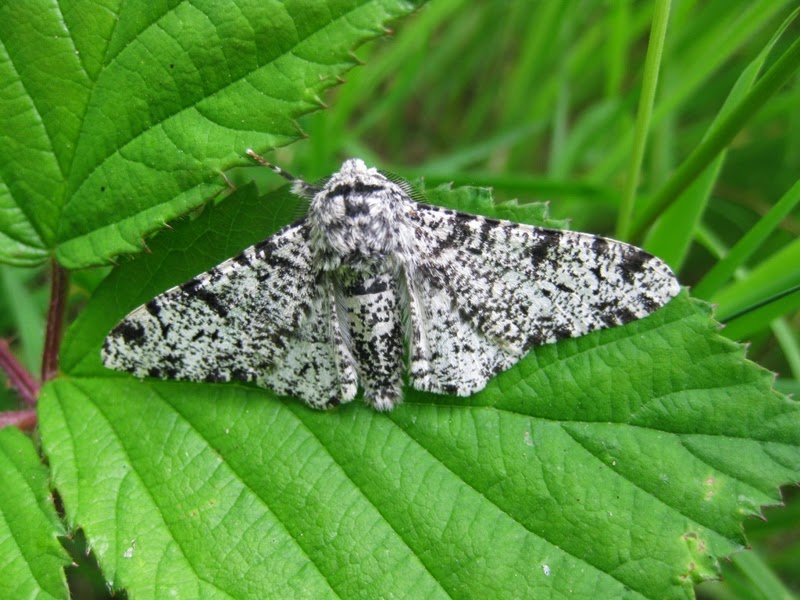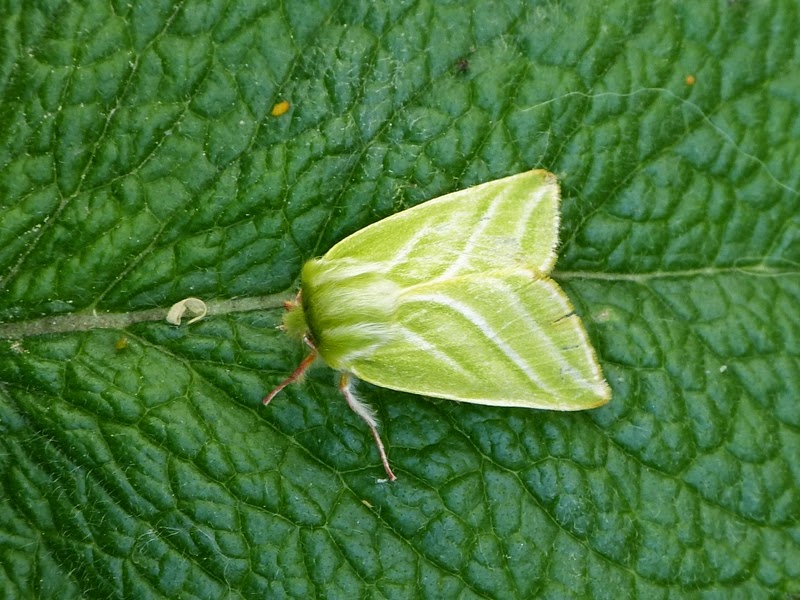I set up the trap on some short grass between a woodland strip and an area of wild bird cover. It seemed like the perfect spot, but shortly after I arrived back home it started to rain, and the rain continued for most of the night.
The next morning I didn't hold out much hope that there would be anything in the trap, so I didn't rush round to the farm too early. When I arrived at the trap there were a number of chickens looking rather intrigued by it! I then noticed that there were not only quite a number of moths inside the trap, but there were about ten moths on the white sheet.
Amazingly, I caught 62 moths that night and 24 different species. Among the many small brown jobs were a number of more interesting moths. This is a Pebble Hook-tip, Drepana falcataria, which had avoided being eaten by the chickens!

This strange-looking moth is a Coxcomb Prominent, Ptilodon capucina, with its blond quiff.
Green seemed to be a popular colour. As well as a Green Silver-lines, that I had previously caught at home, I caught two Green Arches, Anaplectoides prasina. These are lovely moths and they remind me of an old carpet!
I also caught a Green Pug, Pasiphila rectangulata.
I also managed to get a picture of a Brimstone Moth, Opisthograptis luteolata, which pleased me as previously they have flown away when I have taken the lid off the trap!
Probably the most spectacular moth I caught that night was this Northern Eggar, Lasiocampa quercus. It is quite a large moth, with a wing length of about 5 centimetres.
I was excited by this moth, but couldn't find it in my moth book. It turns out to be a Small Magpie, Eurrhypara hortulata, which is classified as a micro moth. Strangely it is bigger than many of the macro moths that I have caught. (Yes, it makes no sense to me, either!!)
I also caught five large Poplar Hawkmoths like I mentioned in my previous post and various brown moths that took me ages to identify. By the time I had emptied the trap, taken pictures of each moth and then identified them all it was nearly lunch time!
I made sure that I released the moths well away from the chickens!
Last weekend I took the trap back to the farm and set it up again. It seemed like the perfect weather so I was hopeful for a big haul. Almost as soon as I switched it on a moth flew straight into the trap! In the morning I was a little disappointed to have only caught 45 moths, and no large ones this time!
However, I still caught 25 species and 13 of them were ones I hadn't caught the week before. It really amazes me how different the results can be only a few days apart.
This one is a Light Emerald, Campaea margaritata.
This is the first Peppered Moth, Biston betularia, I have caught. I remember learning about these at school. There are two or three colour morphs of this moth, and normally the lighter one, like this, is the most common. However, following the Industrial Revolution, with increased pollution levels the darker morph became more common because the trunks of the trees were darker. Today, with our cleaner air the light moths are once again the most common.
I do like the green moths! This is a Green Carpet, Colostygia pectinataria.
Most of the rest of the moths I caught that night were variations on a theme, all much the same shape and colours, such as this Double Square-spot, Xestia triangulum.
So far this year I have caught 48 different species. The person who lent me the trap has told me that he thinks I will catch over 150 species by the end of the year. I had better brush up on my ID skills!





























